#840 Surveyor At Mars October 06, 1997
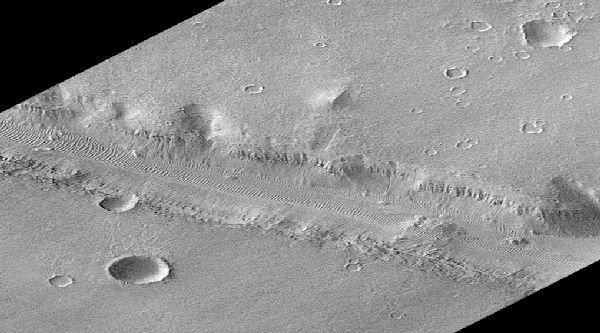
“Mars Global Surveyor achieved Martian orbit on September 11 and began aerobraking into its final mapping orbit, a process that will take until March next year. Anticipating the labors ahead, Mars Orbital Camera operators have begun acquiring test images. This dramatic detail of a recent image shows a 10 mile wide swath of a highland valley, part of the Nirgal Vallis system. The original image was recorded from an altitude of 250 miles at a resolution of about 30 feet per pixel and has been rotated to represent the camera's perspective view. Were these valleys formed by flowing water or did collapse and erosion caused by ground water produced the channel? What other processes were important? Time will tell. From its planned mapping orbit, with four times better resolution, Mars Global Surveyor's images should provide answers to these and other questions about Mars."
Copyright: Public domain
#841 Europe at Night October 07, 1997
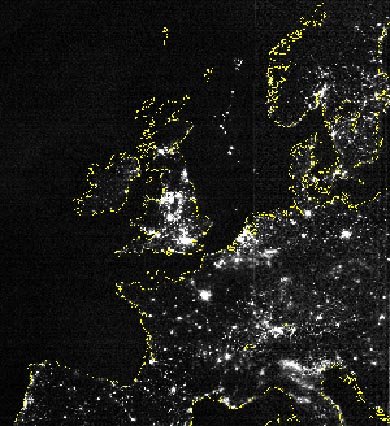
“This is what Europe looks like at night! Can you find your favorite European city? Although not all of Europe is shown, city lights might make this task possible. Continental outlines have been artificially drawn in yellow. The above picture is actually a composite of over 200 images made by satellites orbiting the Earth. Scans were made by the USAF Defense Meteorological Satellite Program (DMSP) Operational Linescan System. The DMSP satellites continue to help in the understanding and prediction of weather phenomena as well as provide key information about population patterns, city light levels, and even rural forest fires."
Copyright: NOAANGDCDMSP
#842 The Brightest Star Yet Known October 08, 1997
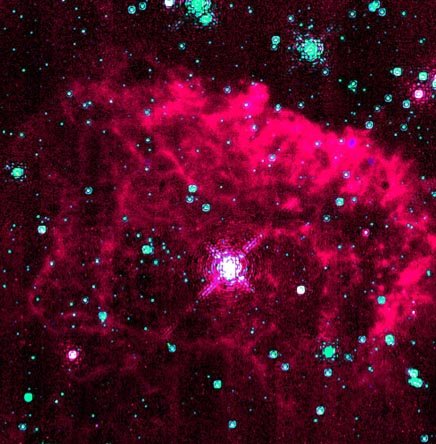
“Star light, star bright, a new brightest star has been discovered in the night. This new brightest star is so far away and so obscured by dust, however, that it took the Hubble Space Telescope to confirm it. In 1990 a star named the Pistol Star was known to lie at the center of the Pistol Nebula. In 1995 it was suggested that the Pistol Star was so massive it was throwing off the mass that actually created the Pistol Nebula. Now, observations from the Hubble Space Telescope released today confirm the spectral relation between the star and the nebula. Dramatic implications include that the star emits 10 million times more light than our Sun, and is about 100 times more massive. Astronomers are currently unsure how a star this massive could have formed and how it will act in the future."
Copyright: Public domain
#843 Hale-Bopp and the North American Nebula October 09, 1997
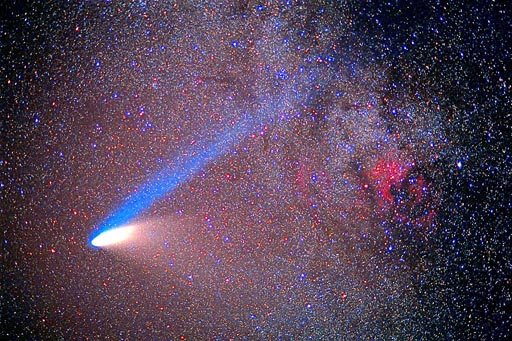
“Comet Hale-Bopp's recent encounter with the inner Solar System allowed many breath-taking pictures. Above, Comet Hale-Bopp was photographed on March 8th in the constellation of Cygnus. Visible on the right in red is the North American Nebula, a bright emission nebula observable from a dark location with binoculars. The North American Nebula is about 1500 light years away, much farther than the comet, which was about 8 light minutes away. Several bright blue stars from the open cluster M39 are visible just above the comet's blue ion tail."
Copyright: J. C. Casado
#844 Mars Pathfinder Super Pan October 10, 1997
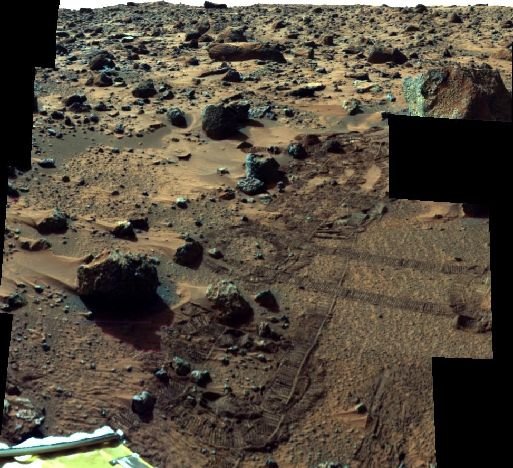
“Spectacular details of rover tracks, wind-driven soil, and textured rocks on the Martian surface fill this color mosaic. The view is north-northeast from the Sagan Memorial Station at the Pathfinder landing site on Mars. These images are just part of the "Super Panorama" - a detailed color and stereo imaging data set being compiled by Pathfinder's IMP camera. The data set will be used to derive detailed topographic maps of the landing site and to further explore the mineralogy of the martian rocks and soil. The forward rover deployment ramp and the rock named Barnacle Bill, appear in the foreground at the left while the larger Yogi rock is partly visible at the upper right. Criss-crossing tracks were made by the cruising Sojourner robot rover's spiked wheels. With three wheels on each side, the two foot long rover makes tracks about 1.5 feet apart."
Copyright: Public domain
#845 Floating Free in Space October 11, 1997
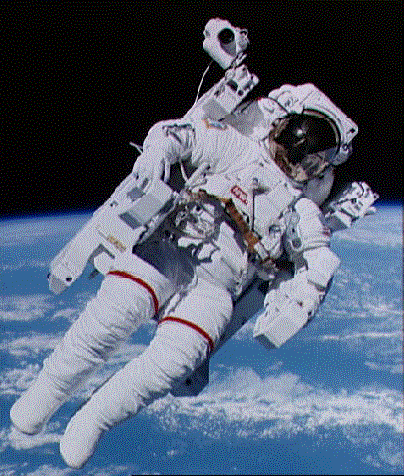
“NASA astronauts can float free in space without any connection to a spaceship. Here astronaut Bruce McCandless maneuvers outside the Space Shuttle Challenger by firing nitrogen gas thrusters on his manned maneuvering unit (MMU). This picture was taken in 1984 and records this first untethered spacewalk. The MMU was developed because astronauts found tethers restrictive."
Copyright: Public domain
#846 Impact! 65 Million Years Ago October 12, 1997
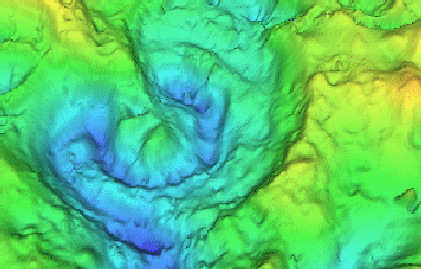
“What killed the dinosaurs? Their sudden disappearance 65 million years ago, along with about 70 percent of all species then living on Earth, is known as the K-T event (Cretaceous-Tertiary Mass Extinction event). Geologists and paleontologists often entertain the idea of a large asteroid or comet impacting the Earth as the culprit. Besides the firestorms, tidal waves, earthquakes, and hurricane winds such an impact would generate, the debris thrown into the atmosphere would have a serious global environmental impact -- creating extended periods of darkness, low temperatures, and acid rains. In 1990, dramatic support for this theory came from cosmochemist Alan Hildebrand's revelation of a 65 million year old, 112 mile wide ring structure still detectable under layers of sediment in the Yucatan Peninsula region of Mexico. The outlines of the structure, called the Chicxulub crater (named for a local village), are visible in the above representation of gravity and magnetic field data from the region. In addition to having the right age, the crater is consistent with the impact of an asteroid of sufficient size (6 to 12 miles wide) to cause the global disruptions. Regardless of the true cause of the K-T event, it is fortunate that such impacts are presently believed to happen only about once every 100 million years!"
Copyright: Public domain
Upvote! Resteem! Comment! As you like it! Thank you for attention!